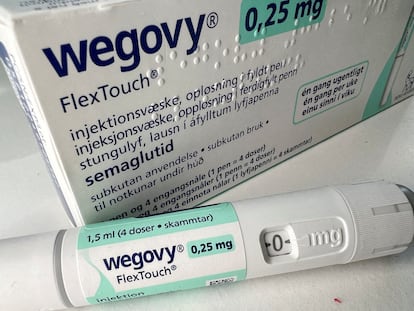The economic disaster of extra pounds: Pharmaceutical companies are profiting in an increasingly obese world
The economic impact of obesity will reach losses of up to $4 trillion by 20235, or 3% of global GDP


Excess weight is very close to being unsustainable on a sick planet. More than 1.5 billion adults and almost 400 million children — one in every four people in the world — will be living with obesity within 12 years, if the condition isn’t stopped. This is especially urgent in countries with fewer resources.
Few chronic diseases have advanced as rapidly in recent decades — regardless of the economic and geographic context — as obesity, which the World Health Organization (WHO) classifies as an epidemic. It’s silent, but devastating. This advance has occurred despite the fact that, over the last decade, efforts have been made to promote healthy lifestyle habits. An example of this was the high-profile Let’s Move campaign launched by Michelle Obama in 2013, in an attempt to reduce the rate of childhood obesity rate in the United States to 5% by 2030.
It hasn’t been enough. Obesity is the elephant in the room that governments must confront, sooner rather than later, due to its devastating toll. If nothing changes, the economic impact of obesity in the world will reach $4.32 trillion in losses annually by 2035, due to medical expenses, absenteeism from work, low productivity, premature retirement and death. This figure represents almost 3% of current global GDP, comparable to the impact of the Covid-19 pandemic in 2020.
The financial cost for being overweight is growing rapidly. In 2019, it accounted for 2.19% of GDP and will grow to 3.29% by 2060. These are the forecasts done by the World Obesity Atlas 2023, published by the World Obesity Federation, which analyzes the economic repercussions of the phenomenon in 161 countries.
Pharmaceutical companies have done big business when it comes to tackling unhealthy body weight. These firms have now turned the fight against obesity into their latest boon. The condition of obesity is believed to be the largest biopharmaceutical market of the decade, with Goldman Sachs estimating a potential turnover of $100 billion annually by 2030. The arrival of new drugs on the market from big pharma firms such as Novo Nordisk and Eli Lilly — drugs that were originally developed and successfully marketed for diabetes, but have also proven effective for weight loss — could mark a turning point in the uncontrolled advance of the disease. Famous people have contributed to the popularity of these medications, such as Kim Kardashian or Elon Musk, who have confessed to having taken semaglutide, which reduces appetite.
The other side of the coin is the food industry, which has filled its pockets in recent decades with the sale of ultra-processed foods. With the advent of these medications, they face a possible loss of business, as well as the challenge of reformulating their products so that they’re healthier without losing their flavor, something that will involve significant investments. Also looking at these weight-loss drugs with some concern are manufacturers of medical devices for obstructive sleep apnea, osteoarthritis and chronic kidney disease, as their income could also be cut.
In 2020, 2.6 billion people were living with excess fat, representing about 38% of the global population, according to the World Obesity Federation. If we talk only about obesity, there are just over 1 billion people: 650 million adults, 340 million adolescents and 39 million children. That is, one in seven citizens, according to the organization.
It’s worrying that so many people have a high body mass index (BMI). The WHO defines obesity as an abnormal or excessive amount of accumulated fat that presents a health risk. For adults, having a BMI greater than or equal to 25 means being overweight, while obesity is defined by a BMI greater than or equal to 30.
A snowball effect
Obesity is a public health problem that has spread rapidly throughout all countries. Since 1975, it has increased almost threefold. The proliferation of sedentary lifestyles, fast foods, sugar and ultra-processed foods have all contributed to this. It also must be taken into account that, in many countries, there are few food alternatives and little access to fruits, vegetables and high-quality proteins, which are too expensive. “No country is immune to the effects of the obesity epidemic, which has become a global health emergency that requires an urgent and imperative response,” notes Francesco Branca, director of the WHO Department of Nutrition and Food Safety.
For this reason, the World Obesity Federation projects that 51% of the world’s population will either be overweight or obese by 2035. The figure is alarming: there are more than four billion people condemned to this complex disease, which is associated with more than 200 health problems and is responsible for the deaths of more than four million people each year. Fat-related diseases are among the top three causes of death worldwide, except in sub-Saharan Africa, according to the report Obesity: Health and Economic Consequences of an Impending Global Challenge, from the World Bank.
The country with the highest percentage of the population suffering from obesity is in the Pacific Islands. In Nauru — the third-smallest country in the world — 94% of the inhabitants are overweight, while diabetes afflicts 66% of people who are over the age of 55. However, as the population is so small — with only 12,511 people — it’s not representative at the global level.
Among the usual suspects is the United States, where more than 70% of adults are obese or overweight and where the disease is the leading cause of death. The same goes for Mexico: about 73% of the population exceeds their recommended weight. Furthermore, 34% of these individuals suffer from morbid obesity (having a BMI greater than 40). In reality, the American continent is one of the most affected by this disease, which will have an annual economic impact of 3.7% of GDP by 2035, according to estimates from the World Atlas of Obesity.

At the bottom is Vietnam, with a 2.1% incidence of obesity in the adult population, according to a flagship report by UNICEF, the WHO and other groups: The State of Food Security and Nutrition in the World (SOFI) report. This document also points to Myanmar, with a 0.8% prevalence of children under the age of five being overweight. However, the disease’s tentacles are long: Vietnam is one of the Southeast Asian countries where obesity rates are increasing the most. The economic growth of the area has caused changes in the lifestyle of citizens and a greater consumption of less healthy diets.
European countries are no exception in the advance of this invisible and devastating epidemic. Many people aren’t faithfully following the much-acclaimed Mediterranean diet. The pathology has been growing since 1980. For instance, about 24% of the Spanish adult population is obese. If overweight people are also taken into account, this figure rises to 61.6%. “The situation is very worrying,” says María del Mar Malagón, president of the Spanish Obesity Society (SEEDO) and a professor of Cell Biology at the University of Córdoba. “If current trends continue, it’s expected that, in 2035, [obesity] will affect 37% of the population. This is especially worrying in children, [as childhood obesity rates will be] increasing by around 2.5% annually until that date.” Data collected by the WHO shows that countries such as Greece and Italy have obesity rates nearing 40%.
A blow to finances
Obesity is strangling public health spending due to the high cost of associated chronic diseases. It’s responsible for 71% of all diabetes treatment costs, 23% of cardiovascular disease expenditure and 9% of cancer costs. These patients — whose life expectancy is reduced by three years on average — require a greater number of medical visits, hospitalizations, laboratory and radiological tests. In OECD countries, on average, obesity has an 8.4% burden on expenses, reducing GDP by 3.3%. In some countries — such as the United States — the burden is even higher, at 14%.
There are a whole series of indirect costs related to obesity. The health-related disorders increase absenteeism from work (there is a 3.4% greater probability on average), reduce productivity and enhance inequalities. “Individuals with at least one chronic disease associated with being overweight are 8% less likely to be employed the following year,” according to The Heavy Burden of Obesity, an OECD study.
Although excess weight has long been seen as an exclusive and distinctive problem of rich countries, it’s now advancing most rapidly in nations with limited resources. Above all, in the urban environments of Asia and Africa, where the Westernization of lifestyles is increasing sedentary habits and poorer nutrition. “Lower-middle income countries with large populations, such as India, Pakistan, Indonesia and Nigeria may quite quickly follow the pattern of upper-middle income countries such as Mexico, Brazil, and Turkey in seeing a rapid rise in obesity prevalence, especially among children and adolescents,” according to the 2023 World Obesity Atlas. We must also not forget “the poor health care services [in these countries that struggle to help with] weight control and health education of the population,” says Fabian Wenner, the analyst responsible for the health sector at Julius Baer.
Raising the alarm about childhood obesity
Obesity rates in children and adolescents have increased tenfold since 1975 worldwide, rising from 11 million people (aged 5 to 19) to 124 million in 2016, according to a study led by Imperial College London and the WHO. “[Obesity rates] are increasing more rapidly among children than among adults,” explains Rachel Jackson-Leach, director of science at the World Obesity Federation. And alarmingly so in low- and middle-income countries, where the little ones are more sensitive to inadequate prenatal and childhood nutrition. “In Africa, the number of overweight children under five years of age has increased by almost 24% since 2000. Almost half of overweight or obese children under five years of age in 2019 lived in Asia,” adds Francesco Branca. The great paradox is that “while childhood obesity grows, the problems of malnutrition remain unresolved,” he laments.
Obesity is a complex, multifactorial, recurrent disease that lacks a curative treatment. “Simplifying it to a single cause can make addressing and treating it even more difficult,” Jackson warns. Ultra-processed foods — available in any corner of the world — are contributing to a rapid increase in the pathology. “An obesogenic environment prevails, characterized by greater availability of cheaper, more energy-dense and less nutritionally beneficial foods,” Malagón affirms. To this, we must add “the rise in physical inactivity due to the increasingly sedentary nature of many forms of work, changes in the means of transportation and increasing urbanization,” Jackson notes.
There are also genetic factors, responsible for between 40% and 70% of the probability of developing obesity. Purchasing power and health education levels, however, are determining factors. “People with lower incomes tend to opt for cheaper foods, often rich in sugar, salt and unhealthy fats, than people with high incomes, who [can afford to] buy more organic foods,” adds Branca from the WHO.
The World Obesity Federation also points to the impact of climate change as being associated with mild and moderate food insecurity, which, in turn, increases the consumption of calorie-rich processed foods, which are available at low cost. Additionally, rising temperatures result in less physical activity in many parts of the world. A final risk factor is chemical contaminants, which affect the endocrine system and promote weight gain. “It’s not a patient’s decision, it’s not a moral illness: the patient doesn’t choose to suffer from obesity, but obesity chooses you at a certain moment,” emphasizes Dr. Albert Lecube, an endocrinologist who acts as vice president of the Spanish Obesity Society (SEEDO).
Not all countries officially recognize obesity as a disease, although it was added to the Sixth International Classification of Diseases (ICD) in 1948. The American Medical Association has registered it as such since 2013. In countries such as Spain — where the National Health System doesn’t finance drugs for its treatment — there’s an intense debate around the issue, since part of the health world and political class don’t consider it to be a disease. Bariatric surgery is only covered for adults with a BMI greater than 40, or greater than 35 with comorbidities… although waiting lists are years-long. In the United States, Medicare covers some bariatric surgical procedures, as well as injections for people with type 2 diabetes.
Drugs such as Ozempic — which have been shown to be effective for weight loss — are the geese that lay golden eggs for pharmaceutical companies, which are competing to reach the top of the obesity market, whose potential has been estimated to be around $100 billion annually by 2023, according to analysts at Goldman Sachs. The investment bank mentions “some of the highest-grossing drugs of all time.” Analysts estimate that Novo Nordisk and Eli Lilly will capture about 80% of the obesity market within seven years. “It possibly represents a huge new market, unparalleled in size and potential, but also a significant benefit for patients, many of whom cannot lose weight on their own by eating differently and playing sports,” says Fabian Wenner from Julius Baer.
The Danish play
The Danish pharmaceutical company Novo Nordisk became the most valuable publicly-listed company in Europe this past September, after surpassing luxury giant LVMH, thanks to the success of its injectable drugs Ozempic and Wegovy. These are two trade names for the same compound: semaglutide. This compound works as an appetite suppressant, by mimicking an intestinal hormone called peptide-1.
Novo Nordisk has recorded a net profit of $9 billion in the first nine months of 2023, with an increase of 47% compared to the same period from the previous year. “Given that there’s an unmet need for people with obesity — and given the magnitude of the problem — we continue to research and develop increasingly innovative and effective drugs that allow us to respond to this problem,” says Francisco Pajuelo, medical director of Novo Nordisk.
Wegovy injections gained approval from the U.S. Food and Drug Administration (FDA) in June 2021 for the treatment of chronic obesity in adults. Meanwhile, Ozempic injections are meant for the treatment of type 2 diabetes and have been approved by the FDA for this purpose. However, the injections — which cost about $150 a pop — are being used by thousands of healthy people to lose weight, since they also inhibit appetite. The demand has been such that the pharmaceutical company has had supply problems, resulting in a black market where counterfeit injections are also being sold. Ozempic’s sales in the first half of 2023 surpassed $60 billion — a 58% year-over-year increase.
This past week, the FDA approved Zepbound, the long-awaited anti-obesity drug from the pharmaceutical company Eli Lilly. The compound — tirzepatide — is the same one contained in the firm’s drug Mounjaro, already approved and prescribed for the treatment of type 2 diabetes. Bloomberg analysts predict that the new brand will grow over the next six years and will dominate the market alongside with Wegovy from Novo Nordisk.
There are more companies competing in this gigantic business. Pfizer is focusing its efforts on the obesity drug danuglipron, which is to be taken orally. Amgen and Viking Therapeutics are also getting into this field, but will need at least another two years before their drugs are approved, according to Wenner.
It’s foreseeable that the market for medications to treat obesity will experience significant growth and that the demand for effective solutions will intensify. “Investment in technology by pharmaceutical multinationals could lead to the development of new medications that help suppress appetite, increase satiety, improve metabolism, or reduce fat absorption,” Pajuelo believes.
The Spanish Society for the Study of Obesity is celebrating the arrival of increasingly effective therapeutic options. “The disease of obesity [has lacked] safe and effective drugs. It’s been fertile soil for the emergence of miracle diets and dietary supplements that have no scientific evidence, as well as a bottomless pit, [with patients suffering from obesity] having been ruthlessly taken advantage of,” Dr. Lecube sighs. For this reason, they’re asking the government for an urgent national plan that considers obesity to be a disease, so as to allow for the financing of new drugs. The European Association for the Study of Obesity (EASO) is already working to develop a European plan against the disease. Of course, pharmaceutical companies warn that these medications cannot be seen as the only tool to lose weight. “The main focus will continue to be lifestyle changes, including healthy eating and regular physical activity,” Pajuelo emphasizes.
It remains to be seen whether public health systems will finance these medications to control excessive weight, or whether patients will have to bear this cost out of pocket, which will undoubtedly lead to an increase in social inequalities. Adopting comprehensive policies will require the careful allocation of resources, but the cost of these medications will be much less than treating so many patients suffering from diabetes, hypertension, cardiovascular disease, sleep apnea syndrome and cancer. According to the OECD, on average, for every dollar invested in preventative measures, a $6 return in economic benefits is achieved.

The industry of indigestible sugar
Soft drinks, sugary drinks, chocolates, candies, ice cream, packaged pastries, instant soups, salty snacks... the list goes on and on. Clearly, the fight to end obesity involves reducing the intake of sugar, salt and saturated fats.
Governments are tackling these foods and beverages with taxes. For instance, more and more countries have applied a tax on sugary drinks. Mexico, the United Kingdom, Finland, France, Norway, South Africa and Peru are just some of them. “They’ve been effective in reducing the sale or consumption of sugar,” affirms Branca, from the WHO. In Spain, the sales tax on sugary beverages went from 10% to 21% in 2021, resulting in a decline in consumption. Other countries — especially in Latin America — have gone further. Colombia has been one of the first to tax ultra-processed products, a measure that has just been launched. By 2025, the sales tax on these products will be at 20%.
Chile, Mexico, Peru and Uruguay, among other countries, have adopted prominent warning labels on processed foods and beverages, in line with the recommendations from the WHO, which also advocates for subsidies to promote healthy diets and the regulation of advertising that targets children with products containing high levels of fat and sugar. The European Commission is working on harmonized and mandatory nutritional labeling on the front of packages. Another option being considered is Nutri-Score, a system that is already used in several countries, such as France and Germany.
The food and beverage industry fears that new labeling regulations, taxes, social pressures and appetite-suppressing drugs will curb consumer spending. Reinvention is the only way they have to save themselves. Many sectors have already taken action. Nestlé — which recently announced that it’s developing products to accompany slimming drugs, such as Ozempic — is one of the most active companies. This past July, the multinational introduced a new “cost-effective technology” that reduces sugars in key ingredients. Through an enzymatic process, it reduces the intrinsic sugar within milk, juices and other beverages by up to 30%, with minimal impact on flavor and texture. “High sugar prices are another incentive to reduce the content of this substance,” points out Wenner from Julius Baer. In some countries — such as Spain — major companies that deal in processed foods and beverages have joined with regulators to reduce added amounts of sugar, salt and saturated fat from thousands of products, according to Enrico Frabetti, director of Food Policy, Nutrition and Health at the Spanish Food and Drink Industry Federation (FIAB).
The main problem is that the reformulation of foods and beverages is a long process that requires significant investment. “It’s impossible to estimate the total cost that will be involved, but it’s likely that producers will pass it on to the consumers with higher prices,” explains Peter Casanova, a global equity analyst at Julius Baer.
Frabetti agrees that the transition will be complex: “We’re talking about qualified personnel, new infrastructure and changes in production processes, from the production of the product itself to the modification of the information transferred to the consumer through the packaging.” Furthermore, not all products may be reformulated for technological reasons — especially when certain ingredients play a key role in the recipe — or sensory reasons. First and foremost, these products need to be accepted by consumers.
Sign up for our weekly newsletter to get more English-language news coverage from EL PAÍS USA Edition
Tu suscripción se está usando en otro dispositivo
¿Quieres añadir otro usuario a tu suscripción?
Si continúas leyendo en este dispositivo, no se podrá leer en el otro.
FlechaTu suscripción se está usando en otro dispositivo y solo puedes acceder a EL PAÍS desde un dispositivo a la vez.
Si quieres compartir tu cuenta, cambia tu suscripción a la modalidad Premium, así podrás añadir otro usuario. Cada uno accederá con su propia cuenta de email, lo que os permitirá personalizar vuestra experiencia en EL PAÍS.
¿Tienes una suscripción de empresa? Accede aquí para contratar más cuentas.
En el caso de no saber quién está usando tu cuenta, te recomendamos cambiar tu contraseña aquí.
Si decides continuar compartiendo tu cuenta, este mensaje se mostrará en tu dispositivo y en el de la otra persona que está usando tu cuenta de forma indefinida, afectando a tu experiencia de lectura. Puedes consultar aquí los términos y condiciones de la suscripción digital.
More information
Archived In
Últimas noticias
Welcome to the post-religion era: The idea of Christianity as the absolute truth has become obsolete
‘I thought you would like it’: The risky sexual practice popularized by TV shows and TikTok
The digitalization of tourism: ‘They promise experiences and gave us the worst possible one’
Mexican peso defies uncertainty with forecasts of a new period of stability in 2026
Most viewed
- Sinaloa Cartel war is taking its toll on Los Chapitos
- Reinhard Genzel, Nobel laureate in physics: ‘One-minute videos will never give you the truth’
- Oona Chaplin: ‘I told James Cameron that I was living in a treehouse and starting a permaculture project with a friend’
- Why the price of coffee has skyrocketed: from Brazilian plantations to specialty coffee houses
- Silver prices are going crazy: This is what’s fueling the rally










































